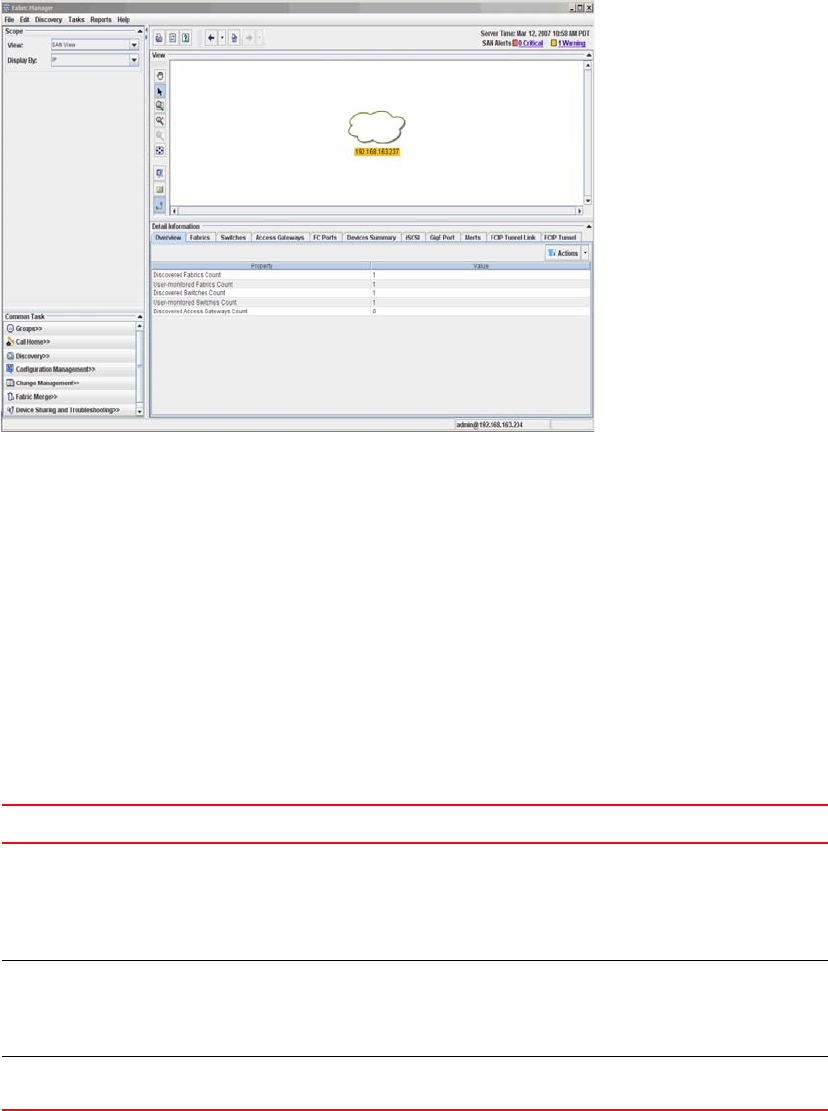DCFM Migration and Transition Guide v10.0.1 (53-1001074-01, December 2008)
Table Of Contents
- Contents
- About This Document
- Installation
- In this chapter
- Requirements
- Professional edition installation
- Installing Professional edition on Windows systems
- Professional edition pre-installation requirements on UNIX systems
- Installing Professional edition on UNIX systems
- Professional edition pre-installation requirements (headless)
- Installing Professional edition on UNIX systems (headless)
- Troubleshooting the Linux installation
- Enterprise trial installation
- Enterprise trial requirements
- Installing Enterprise trial on Windows systems
- Enterprise trial pre-installation requirements on UNIX systems
- Installing Enterprise trial on UNIX systems
- Enterprise trial pre-installation requirements on UNIX systems (headless)
- Installing Enterprise trial on UNIX systems (headless)
- Enterprise edition installation
- Installing enterprise edition on Windows systems
- Enterprise edition pre-installation requirements on UNIX systems
- Installing Enterprise edition on UNIX systems
- Enterprise edition pre-installation requirements on UNIX systems (headless)
- Installing Enterprise edition on UNIX systems (headless)
- Installing the ODBC driver
- Smart Card driver installation (Linux and Solaris only)
- Configuring an explicit server IP address
- Uninstall
- Migration
- In this chapter
- Headless installation information
- Professional edition migration
- Professional edition pre-migration requirements on Windows systems
- Migrating from Professional edition to Enterprise edition on Windows systems
- Professional edition pre-migration requirements on UNIX systems
- Migrating from Professional edition to Enterprise edition on UNIX systems
- Professional edition pre-migration requirements on UNIX systems (headless)
- Migrating from Professional edition to Enterprise edition on UNIX systems (headless)
- Troubleshooting Linux installation
- Enterprise trial migration
- Enterprise trial requirements
- Enterprise trial pre-migration requirements on Windows systems
- Migrating from Enterprise trial to Enterprise edition on Windows systems
- Enterprise trial pre-migration requirements on UNIX systems
- Migrating from Enterprise trial to Enterprise edition on UNIX systems
- Enterprise trial pre-migration requirements on UNIX systems (headless)
- Migrating from Enterprise trial to Enterprise edition on UNIX systems (headless)
- EFCM migration
- Importing names
- Fabric Manager migration
- Transition
- Index

DCFM Migration and Transition Guide 101
53-1001074-01
3
Fabric Manager transition
The visual differences between Fabric Manager and DCFM are large. Many of the functions remain,
but the information is arranged very differently and often accessed in a different way.
FIGURE 47 FM main interface
1. Menu Bar - Lists commands you can perform on the SAN.
2. Scope panel - Provides fields and values you can use to define the SAN view in the View panel.
3. View panel - Displays the SAN topology, including discovered and monitored devices and
connections.
4. Task panel - Lists the common tasks that can be performed on devices discovered in the SAN.
5. Information panel - Displays the properties of the selected fabrics and devices.
Only the Menu Bar and View Panel have been recognizably retained. The View panel is now know as
the Connectivity Map. Table 12 briefly describes the mapping of the FM functions and visual panels
to DCFM.
TABLE 12 Fabric Manager to DCFM function mapping
Fabric Manager Feature/panel DCFM
Views are scoped or grouped by selecting SAN,
Fabric, HostStorage, or MetaSAN from the View
drop-down. Views are further scoped by selecting
sub-options. Choices appear in the Scope panel.
Views are scoped by selecting nodes from the Product
List, and by selecting options from the View drop-down
menu above the Product List. Multiple custom views can
be created and saved using the menu command View >
Manage View > Create View.
Properties are grouped in a set of tabs under the
Fabric view (topology) panel.
Properties for various objects can be viewed by
right-clicking on the object in either the Connectivity Map
or in the Product List. Selected properties are also
displayed in tabular form in the Product tree table.
Context-sensitive tasks are launched from the
Common Task panel.
Most context-sensitive tasks can be accessed from a
right-click menu on an object.










